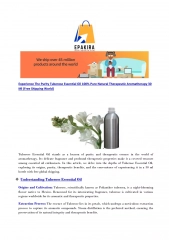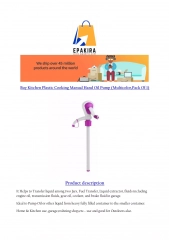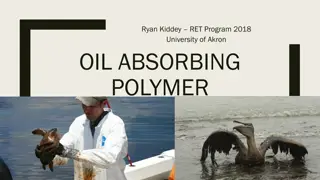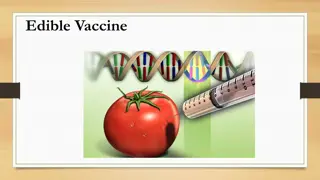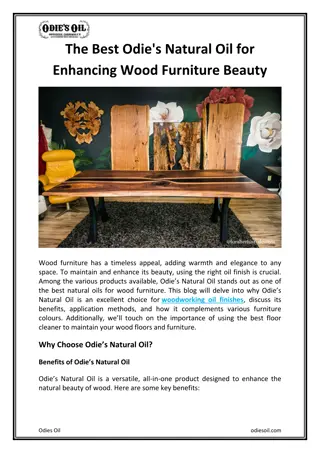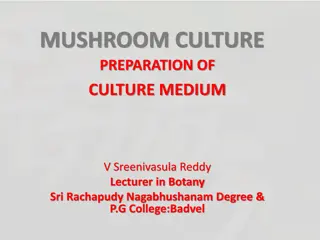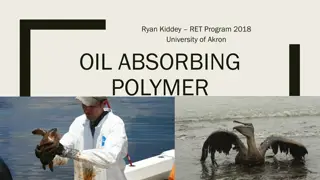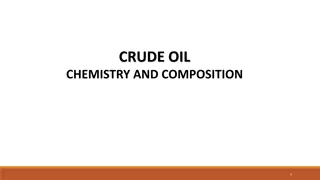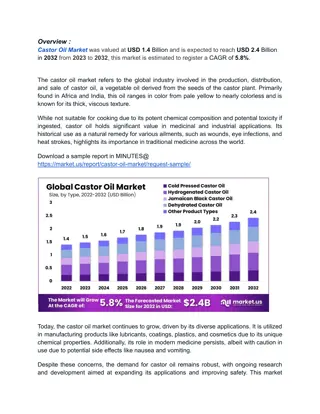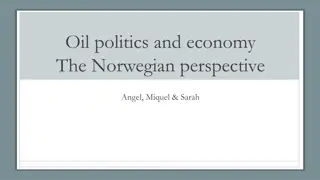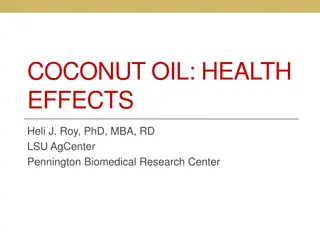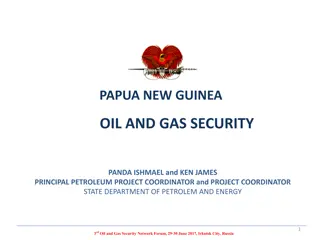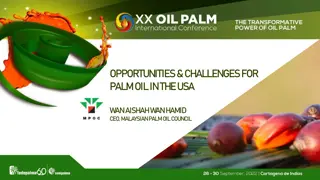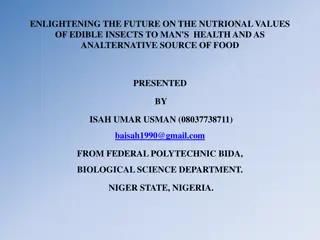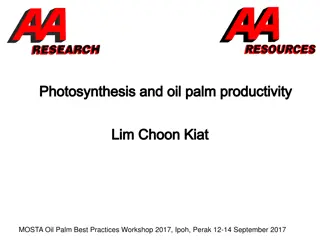Understanding the Processing of Edible Oil: A Comprehensive Overview
Crude vegetable oil undergoes a refining process before becoming suitable for consumption. This process involves removal of impurities and chemical treatments to ensure high-quality edible oil. Various manufacturing steps are followed to produce refined edible oil, including super cleaning, conto-bleaching, and de-acidification. The Edible Oil Refinery consists of critical components like neutralizer, bleacher, deodorizer, and thermic fluid boiler among others. Equipment such as raw oil tanks, bleached oil tanks, and filtration systems are essential for refining the oil to meet industry standards. The specifications of an Edible Oil Refinery with a 5-ton capacity are also detailed.
Download Presentation

Please find below an Image/Link to download the presentation.
The content on the website is provided AS IS for your information and personal use only. It may not be sold, licensed, or shared on other websites without obtaining consent from the author. Download presentation by click this link. If you encounter any issues during the download, it is possible that the publisher has removed the file from their server.
E N D
Presentation Transcript
PROCESSING OF EDIBLE OIL Mrs. Rajesh Kumari Lecturer in Food Technology Department CBLGP, Bhiwani
CONTENTS INTRODUCTION MANUFACTURING PROCESS OIL REFINING PROCESS FLOW DIAGRAM OIL REFINERY EQUIPMENT PROCESS DESCRIPTION OF EDIBLE OIL REFINERY
INTRODUCTION Crude vegetable oil obtained from various oil milling units is further refined before use for edible purposes. Refined edible oil is a process where free fatty acids are volatized, condensed and recovered simultaneously with vacuum de-colouring operation. Sometimes, refining process is limited to simple physical treatment such as heating and filtering in regard to refining of superior quality of crude oil.
MANUFACTURING PROCESS Special Pre-treatment steps which are a combination of De De- -gumming gumming and Blending Blending under special operating conditions eliminate all impurities impurities and render oil processed at elevated temperature under vacuum. fit to be Various steps involved in refining are : (I) Super cleaning (2) Contobleaching and (3) De-acidification. All these processes are very well standardized and practiced in the country since long.
EDIBLE OIL REFINERY EDIBLE OIL REFINERY CONSIST FOLLOWING NEUTRALIZER BLEACHER DEODORIZER THERMIC FLUID BOILER / STEAM BOILER FILTER PRESS CONDENSER TOWER ALL TANKS i.e. raw oil tank, bleached oil tanks, ALL STEEL STRUCTURE WATER COOLING SYSTEM ALL PUMPS AND ALL NECESSARY EQUIPMENTS. FOR CRUDE PALM OIL REFINERY ADDITIONALEQUIPMENTIS REQUIRED CHILLING PLANT AND CRYSTALLIZING VESSEL FOR FRACTIONATION PROCESS. EQUIPMENTS: soap stock tanks I.E.
Edible Oil Refinery(5 tons capacity) 1. 2. 3. 4. 5. 6. 7. 8. 9. 10. 11. 12. Neutralizer Neutralizer Bleacher Deodourizer Cooler Thermic Fluid Filter Press Filter Press Raw Oil Tank Bleach Oil Tank Soap Pan Soap Pan Boiler Steam generator and vaccum pump are on the back side and so can not be seen. Berometric 40ft. tower not shown. Condensor and catchalls with
Specifications of Edible Oil Refinery : Capacity 5 tons per day i.e. 4 batches of 1250 kg each All the main vessels i.e. two neutralizers, one bleacher and one deodorizer are properly arranged on the first floor of the steel structure. So all these vessels are hanging on the steel structure. Just below the two neutralizers, two soap pans are resting on the ground floor in which soap stock is collected. There is a steam pipe arrangement in the soap pans also. Steel structure has size of 14ft.x 14ft. (i.e. 4.25mtr. x 4.25mtr). First floor is 9ft. above the groundlevel. There are 8 columns of double channel which supports the entire steel structure. It has proper staircase and railing on all the sides of steel structure at the first floor and also on staircase. Two filter presses are also accommodated on the first floor of the steel structure. Two oil tanks i.e. raw oil tank and bleached oil tank are accommodated under the structure on the ground floor. Then cooler, thermic fluid boiler, two steam generators, vacuum pump, water pumps, oil pumps and refined oil tank are arranged on the ground floor around the steel structure i.e. outside the square of 14ft. x 14ft. of the steel structure. So total space occupied is about 30ft. 30ft. (9mtr. x 9mtr.) 40ft. tower is erected just near the deodorizer and its complete structure is supported from the ground floor and also it is attached with the refinery structure. Barometric condenser is arranged at 40ft. height to create proper vacuum.
All types of pipelines are interconnected as per the requirement of the refinery i.e. oil pipelines (yellow color), vacuum pipelines (blue color), steam pipelines (black color), water pipelines (white color), thermic fluid pipelines (red color). At all appropriate places, proper valves are provided in the pipelines. Neutralizer is provided with thermic fluid coil for heating the oil. Bleacher is provided with double pipe coil. One is for thermic fluid and another is for cooling water. Deodorizer is provided with double pipe coil i.e. in both the coils, thermic fluid is circulated. Steam is ejected from the stainless nozzles provided on the steam pipe cross supported at the bottom. Cooler is provided with double pipe coil. Both for cooling water. In every vessel temperature gauge is provided. Vacuum gauge is provided on deodorizer, bleacher and cooler. Neutralizer is open on the top having conical bottom. Bleacher has dished ends on both the sides. Similarly deodorizer has dished ends on both the sides. Cooler has also dished ends on both the sides.
Process Description of Edible Oil Refinery : For refining the edible oil, there are three basic processes in the refinery. First process is neutralizing the oil in the neutralizer to remove the Free Fatty Acids (FFA) by adding caustic soda. Oil is heated up to about 60 C by thermic fluid coils and oil is stirred by stirrer. Then soap stock formed due to chemical reaction is allowed to settle at the bottom the neutralizer from where it is taken out into soap pan. of Neutralized oil is drawn into the second vessel called bleacher where color of oil is removed by bleaching process with aid of chemicals such as carbon black and bleaching earth. Oil is generally heated up to 110 Cby thermic fluid coils. Stirring is also continued. Bleaching process is done under vacuum.
Process Description of Edible Oil Refinery : Bleached oil then goes to the filter press where bleaching earth and chemicals are separatedand clean bleachedoil is then drawn to deodorizer where oil is heated above 110 C through thermic fluid coils and then live steam is given to the oil from the bottom steam nozzles and temperature of oil is raised up to 200 to 220 Cthrough thermic fluid coils. Entire process is done under high vacuum. Thus smell is removed from the oil in the deodorizer. Then it goes to cooler where water circulating coils take away heat and oil is cooled. Again it goes to second filter press where completely refined and transparent color less oil is obtained. Steam Generator etc. play their role in the refining process. So these equipments are part of the refinery and connected with the vessels through pipelines. Thermic Fluid Boiler, Vacuum Pump, Barometric Condenser, Catchalls,
REFINING Refining produces an edible oil with characteristics that consumers desire such as: Bland flavor Odor Clear appearance Light color Stability to oxidation Suitability for frying.
REFINING The following precautionary measures are taken during refining in order to avoid undesirable autoxidation and polymerization reactions: 1. 2. 3. Absence of oxygen Avoidance of heavy metal contaminations Maintaining the processing temperature as low and duration as short as possible.
REFINING Refining process comprising the following steps: 1. 2. 3. 4. 5. Lecithin removal Degumming Free fatty acid removal Bleaching Deodorization
R Rem emo oval val of of lecithin lecithin This processing step is special importance for soybean oils . Water (2-3%) is added to crude oil, thereby enriching the phospholipids in the oil/water interface. The emulsion thus formed is heated up to 80 and then separated or clarified by centrifugation.
D De egumming gumming Finely dispersed protein and carbohydrate are coagulated in oil by addition of phosphoric acid ( 0.1 % of oil weight ). A filtering aid is then added and the oil is clarified by filteration.
Removal of Free Fatty Acids (deacidification ) The removal of fatty acids with 15 % sodium hydroxide is most frequently used method. Technically , this is not very simple since fat hydrolysis has to be avoided and , moreover , the sodium soap which tends to forms\ stable emulsions , has to be washed out by hot water. After vacuum drying , the fat or oil may contain only about 0.05 % free fatty acids and 60 to 70 ppm of sodium soaps. When fat or oil is treated with diluted phosphoric acid , the content sodium soaps decreases to 20 ppm and part of the trace heavy-metal ions is removed. (alkali refining) of
Blea Bleac ching hing In order to remove the plant pigment (chlorophyll , carotenoids ) autoxidation products, the fat or oil is stirred for 30 min in the presence of Al-silicates ( bleaching or Fuller s earth ) in a vacuum 90 . and at The bleached oil is removed from the adsorbent by filteration . The retained by the absorbent can be recovered by hexane extraction and recycled into refining process.
Deodoriz Deodoriza ation tion ( 190-230 , Deodorization is essentially vacuum steam distillation 0.5-10 mbar ) . The volatile compounds , together with undesirable odorants present in the fat or oil , are separated in refining steps Deodorization takes place min 20 in to 6 h depending on the type of fat or oil and the content of volatile compounds.
THANK THANK Y YOU OU


